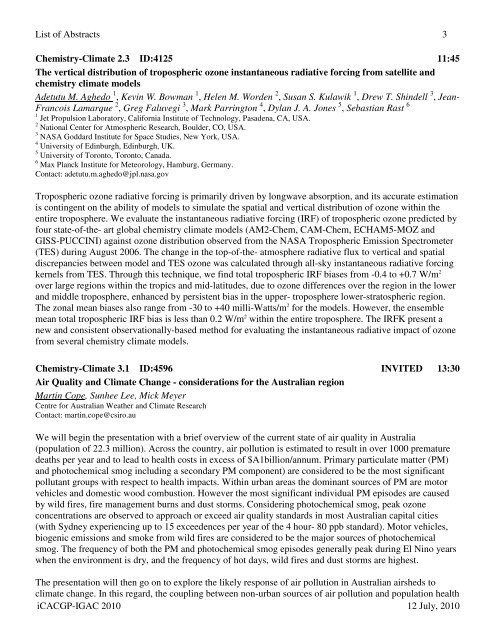Download Abstracts Here - IGAC Project
Download Abstracts Here - IGAC Project
Download Abstracts Here - IGAC Project
Create successful ePaper yourself
Turn your PDF publications into a flip-book with our unique Google optimized e-Paper software.
List of <strong>Abstracts</strong> 3Chemistry-Climate 2.3 ID:4125 11:45The vertical distribution of tropospheric ozone instantaneous radiative forcing from satellite andchemistry climate modelsAdetutu M. Aghedo 1 , Kevin W. Bowman 1 , Helen M. Worden 2 , Susan S. Kulawik 1 , Drew T. Shindell 3 , Jean-Francois Lamarque 2 , Greg Faluvegi 3 , Mark Parrington 4 , Dylan J. A. Jones 5 , Sebastian Rast 61 Jet Propulsion Laboratory, California Institute of Technology, Pasadena, CA, USA.2 National Center for Atmospheric Research, Boulder, CO, USA.3 NASA Goddard Institute for Space Studies, New York, USA.4 University of Edinburgh, Edinburgh, UK.5 University of Toronto, Toronto, Canada.6 Max Planck Institute for Meteorology, Hamburg, Germany.Contact: adetutu.m.aghedo@jpl.nasa.govTropospheric ozone radiative forcing is primarily driven by longwave absorption, and its accurate estimationis contingent on the ability of models to simulate the spatial and vertical distribution of ozone within theentire troposphere. We evaluate the instantaneous radiative forcing (IRF) of tropospheric ozone predicted byfour state-of-the- art global chemistry climate models (AM2-Chem, CAM-Chem, ECHAM5-MOZ andGISS-PUCCINI) against ozone distribution observed from the NASA Tropospheric Emission Spectrometer(TES) during August 2006. The change in the top-of-the- atmosphere radiative flux to vertical and spatialdiscrepancies between model and TES ozone was calculated through all-sky instantaneous radiative forcingkernels from TES. Through this technique, we find total tropospheric IRF biases from -0.4 to +0.7 W/m 2over large regions within the tropics and mid-latitudes, due to ozone differences over the region in the lowerand middle troposphere, enhanced by persistent bias in the upper- troposphere lower-stratospheric region.The zonal mean biases also range from -30 to +40 milli-Watts/m 2 for the models. However, the ensemblemean total tropospheric IRF bias is less than 0.2 W/m 2 within the entire troposphere. The IRFK present anew and consistent observationally-based method for evaluating the instantaneous radiative impact of ozonefrom several chemistry climate models.Chemistry-Climate 3.1 ID:4596 INVITED 13:30Air Quality and Climate Change - considerations for the Australian regionMartin Cope, Sunhee Lee, Mick MeyerCentre for Australian Weather and Climate ResearchContact: martin.cope@csiro.auWe will begin the presentation with a brief overview of the current state of air quality in Australia(population of 22.3 million). Across the country, air pollution is estimated to result in over 1000 prematuredeaths per year and to lead to health costs in excess of $A1billion/annum. Primary particulate matter (PM)and photochemical smog including a secondary PM component) are considered to be the most significantpollutant groups with respect to health impacts. Within urban areas the dominant sources of PM are motorvehicles and domestic wood combustion. However the most significant individual PM episodes are causedby wild fires, fire management burns and dust storms. Considering photochemical smog, peak ozoneconcentrations are observed to approach or exceed air quality standards in most Australian capital cities(with Sydney experiencing up to 15 exceedences per year of the 4 hour- 80 ppb standard). Motor vehicles,biogenic emissions and smoke from wild fires are considered to be the major sources of photochemicalsmog. The frequency of both the PM and photochemical smog episodes generally peak during El Nino yearswhen the environment is dry, and the frequency of hot days, wild fires and dust storms are highest.The presentation will then go on to explore the likely response of air pollution in Australian airsheds toclimate change. In this regard, the coupling between non-urban sources of air pollution and population healthiCACGP-<strong>IGAC</strong> 2010 12 July, 2010








